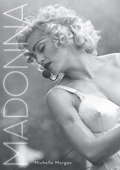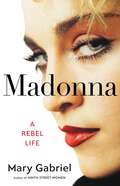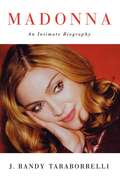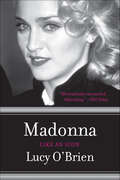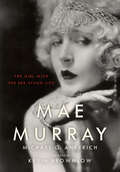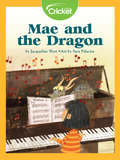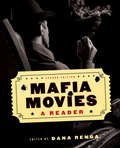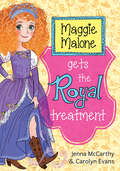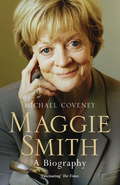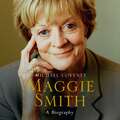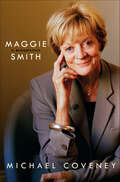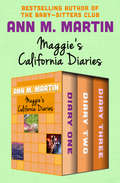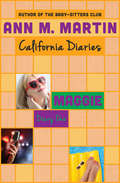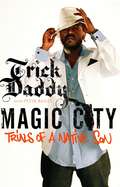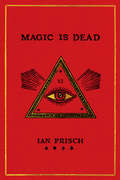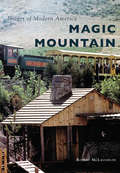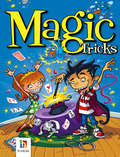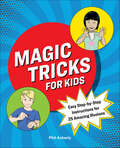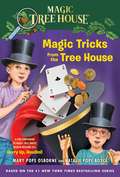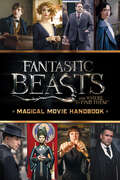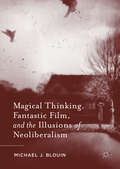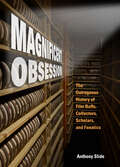- Table View
- List View
Madonna
by Michelle MorganMadonna: singer, songwriter, actress, businesswoman, not to mention one of the most renowned cultural icons of the last three decades. Since her first, eponymous album, over thirty years ago Madonna has sold a remarkable 300 million records worldwide, making her the top-selling female recording artist of all time.Madonna is famous for continuously reinventing both her music and her image. By pushing the boundaries of mainstream popular music with both her lyrical content and the imagery in her music videos she achieved extraordinary popularity. Morgan offers a richly illustrated, comprehensive account of the artist's phenomenally successful career shedding new light on her videos, books, tours, fashion, charity work and every other aspect of her life.Praise for Marilyn Monroe: Private and Undisclosed:'A gorgeous collection offering a fascinating insight into Monroe's personal life' Women & Home'A touching portrayal of the star in her more private moments' Empire'The most authoritative book on the star to date' Choice
Madonna: A Rebel Life
by Mary GabrielNew York Times Editors&’ Choice, One of NPR&’s Best Books of the YearIn this &“infinitely readable&” biography, award-winning author Mary Gabriel chronicles the meteoric rise and enduring influence of the greatest female pop icon of the modern era: Madonna (People Magazine) With her arrival on the music scene in the early 1980s, Madonna generated nothing short of an explosion—as great as that of Elvis or the Beatles—taking the nation by storm with her liberated politics and breathtaking talent. Within two years of her 1983 debut album, a flagship Macy's store in Manhattan held a Madonna lookalike contest featuring Andy Warhol as a judge, and opened a department called &“Madonna-land.&” But Madonna was more than just a pop star. Everywhere, fans gravitated to her as an emblem of a new age, one in which feminism could shed the buttoned-down demeanor of the 1970s and feel relevant to a new generation. Amid the scourge of AIDS, she brought queer identities into the mainstream, fiercely defending a person's right to love whomever—and be whoever—they wanted. Despite fierce criticism, she never separated her music from her political activism. And, as an artist, she never stopped experimenting. Madonna existed to push past boundaries by creating provocative, visionary music, videos, films, and live performances that changed culture globally. Deftly tracing Madonna&’s story from her Michigan roots to her rise to super-stardom, master biographer Mary Gabriel captures the dramatic life and achievements of one of the greatest artists of our time.
Madonna: An Intimate Biography
by J. Randy TaraborrelliMadonna! Megastar. Lover. Mother. Opportunist. Chameleon. Role model. She's all of these things...and more. Yet, who is she, really? In Madonna: An Intimate Biography, author J. Randy Taraborrelli's scrupulously researched and completely balanced unauthorized biography of one of the world's most celebrated entertainers, the reader is allowed to draw his or her own conclusions. Indeed, the portrait bestselling author Taraborrelli paints here is of a truly complex woman, one who is driven and determined to succeed at any cost, yet who displays remarkable vulnerability when it comes to matters of the heart. It is significant that Madonna: An Intimate Biography is the first such book written about the star in over a decade, because in the past ten years the ever-changing Madonna has gone through her biggest transformation yet -- from tempestuous sex goddess to happily married mother. Amazingly, as she launches her first worldwide tour in eight years, she is now -- at forty-something -- enjoying one of the most successful periods of her groundbreaking career. Whereas other books about Madonna have been based on previously published material, Madonna: An Intimate Biography is the result of ten years of exclusive interviews with people who are speaking publicly about her for the first time, including close friends, business associates and even family members. Since Taraborrelli interviewed the star herself early in her career, he is now able to draw from such firsthand experiences to place her success story in perspective and provide new, stunning insights. The true Madonna, as presented here, is not merely a sensation-seeking tabloid vixen, but a flesh-and-blood woman with human foibles and weaknesses -- as well as great strengths and ambitions. For the first time, the reader learns about the complex nature of her difficult relationship with her father, and how the two finally found one another after years of estrangement; how Warren Beatty broke her heart, and why the two never wed; how she and John Kennedy, Jr., became romantically involved, his mother's reaction to the prospect of Madonna as a daughter-in-law and why it could never have worked out; the truth of her relationships with the fathers of her two children and how, as a loving and attentive mother, she has evolved into a surprisingly different woman...and what the future holds for her. Madonna: An Intimate Biography is a truly explosive and definitive account of the life of an entertainer who is undoubtedly one of the most popular, trendsetting figures of our time. Full of amazing disclosures about her private life and public career, New York Times bestselling author J. Randy Taraborrelli's latest work reveals Madonna in a new -- and surprisingly inspiring -- way. Not only a feast for fans, this book is great entertainment for anyone who enjoys a remarkable story, stirringly told.
Madonna: Like an Icon
by Lucy O'BrienMaterial Girl . . . Immaculate sexpot . . . Superstar . . . Mother . . . Kabbalah enthusiast . . . For three decades she has defied categorization. . . . She remains one of our greatest living pop icons.Here is the groundbreaking biography that finally solves the mystery at the heart of Madonna's chameleonlike existence. Drawing upon scores of candid interviews with producers, musicians, collaborators, lovers, and friends, Lucy O'Brien's Madonna: Like an Icon explores the complex personality and legendary drive that have made Madonna the most famous female pop artist of our time. From her mother's premature death to Madonna's dynamic arrival on the New York club scene, from "Like a Virgin" to Evita and beyond, every stage of this dazzling star's life and career is brilliantly illuminated—the stereotypes deconstructed, the lies exposed, the artist examined, the legend celebrated.
Mae Murray: The Girl with the Bee-Stung Lips (Screen Classics)
by Michael G. AnkerichThis story of a silent-film star&’s rise and fall offers &“a lesson about those heady days of early Hollywood and the transience of fame&” (Library Journal). Renowned for her classic beauty and charismatic presence, Mae Murray rocketed to stardom as a dancer in the Ziegfeld Follies, moving across the country to star in her first film, To Have and to Hold, in 1916. An instant hit with audiences, Murray soon became one of the most famous names in Tinseltown. But Murray&’s moment in the spotlight was fleeting. The introduction of talkies, a string of failed marriages, a serious career blunder, and a number of bitter legal battles left the former star in a state of poverty and mental instability that she would never overcome. In this intriguing biography, Michael G. Ankerich traces Murray&’s career from the footlights of Broadway to the klieg lights of Hollywood, recounting her impressive body of work on the stage and screen and charting her rapid ascent to fame and decline into obscurity. Featuring exclusive interviews with Murray&’s only son, Daniel, and with actor George Hamilton, whom the actress closely befriended at the end of her life, Ankerich restores this important figure in early film to the limelight. &“If Billy Wilder hasn&’t made the definitive movie about the delusions of stardom in Sunset Boulevard, Murray&’s story, a blend of absurdity and pathos, would make a terrific one.&” —TheWashington Post Includes photos
Mae and the Dragon
by Jacqueline WestMae is not fond of her piano lessons. Her mindset changes when she encounters a magical dragon who eats music.
Mafia Movies
by Dana RengaRico 'Little Caesar' Bandello, Michael Corleone, and Tony Soprano are just some of the onscreen mafia figures that have fascinated audiences since cinema's inception. Portrayals of the Italian and Italian-American mafia, though, have differed markedly over time and across multiple cultures--from the Godfather trilogy to contemporary Italian films, and in works both by established producers like Martin Scorsese and emerging directors like Matteo Garrone.Mafia Movies encourages mafia aficionados to explore the rich variety of classics and rarities within the genre with provocative analyses of over forty films. The essays in this volume provide a comprehensive exploration of the myth of the mafia onscreen, identifying key features and connections to styles such as film noir, thrillers, and even westerns. Mafia Movies also questions whether there are uniquely American or Italian ways of depicting the mafia, exploring how filmmakers from both countries have approached the subject in divergent ways.
Mafia Movies: A Reader, Second Edition (Toronto Italian Studies)
The mafia has always fascinated filmmakers and television producers. Al Capone, Salvatore Giuliano, Lucky Luciano, Ciro Di Marzio, Roberto Saviano, Don Vito and Michael Corleone, and Tony Soprano are some of the historical and fictional figures that contribute to the myth of the Italian and Italian-American mafias perpetuated onscreen. This collection looks at mafia movies and television over time and across cultures, from the early classics to the Godfather trilogy and contemporary Italian films and television series. The only comprehensive collection of its type, Mafia Movies treats over fifty films and TV shows created since 1906, while introducing Italian and Italian-American mafia history and culture. The second edition includes new original essays on essential films and TV shows that have emerged since the publication of the first edition, such as Boardwalk Empire and Mob Wives, as well as a new roundtable section on Italy’s “other” mafias in film and television, written as a collaborative essay by more than ten scholars. The edition also introduces a new section called “Double Takes” that elaborates on some of the most popular mafia films and TV shows (e.g. The Godfather and The Sopranos) organized around themes such as adaptation, gender and politics, urban spaces, and performance and stardom.
Magazinjournalismus im Fernsehen: Ein Handbuch für Ausbildung und Praxis (Journalistische Praxis)
by Kim Otto Claudio Höll Andreas ElterDas Trainingshandbuch Magazinjournalismus Fernsehen gibt Journalismusstudierenden und Journalistinnen und Journalisten einen Leitfaden zur Produktion eines Fernsehmagazinbeitrags an die Hand. Mit Praxisbeispielen wird gezeigt, wie Magazinjournalismus gelingt, der seine Zuschauer bannt und informiert und so Teil der öffentlichen Debatte wird. Das Trainingshandbuch fokussiert sich auf die Praxis: Von der Themenrecherche über Interviewtechniken bis zum fertigen Beitrag begleitet das Buch Sie in allen Schritten zu Ihrem Fernsehmagazinbeitrag.
Maggie Forevermore
by Joan Lowery NixonHappy living with her Texas grandmother and looking forward to celebrating a family Christmas, thirteen-year-old Maggie is devastated when she is summoned by her movie-director father to spend Christmas with him and her very young stepmother in California.
Maggie Malone Gets the Royal Treatment
by Carolyn Evans Jenna MccarthyWalking a mile in someone else's shoes can be a royal pain Everyday is Freaky Friday for Maggie Malone and her Mostly Magical Boots. Whenever she slips on the MMBs, Maggie gets to be whomever she wants for a whole day. And whose life could be more fun to try on than the glamorous Princess Wilhelmina of Wincastle's? Even better, Wilhelmina is a bridesmaid in the Royal Wedding of the Century! But even pampered princesses have whopper-sized problems-and hers is an evil archenemy named Penelope. Will she survive Penelope's tricks or will the whole wedding turn into a royal disaster?
Maggie Smith: A Biography
by Michael Coveney'Coveney is the only writer who could get under Smith's skin, capturing her steeliness and vulnerability' INDEPENDENT ON SUNDAYFrom her days as a star of West End comedy and revue, Dame Maggie's path has led to international renown and numerous accolades including two Academy Awards. Recently she has been as prominent on our screens as ever, with high-profile roles as the formidable Dowager Countess of Grantham in DOWNTON ABBEY, as Professor Minerva McGonagall in the HARRY POTTER movie franchise and as the eccentric Miss Shepherd in the film version of THE LADY IN THE VAN by Alan Bennett. Paradoxically she remains an enigmatic figure, rarely appearing in public and carefully guarding her considerable talent. Drawing on personal archives, interviews and encounters with the actress, as well as conversations with immediate family and dear friends, Michael Coveney's biography is a captivating portrait of the real Maggie Smith.
Maggie Smith: A Biography
by Michael CoveneyNo one does glamour, severity, girlish charm or tight-lipped witticism better than Dame Maggie Smith, one of Britain's best-loved actors. This new biography shines the stage-lights on the life and career of a truly remarkable performer, one whose stage and screen career spans six decades.From her days as a West End star of comedy and revue, Dame Maggie's path would cross with those of the greatest actors, playwrights and directors of the era. Whether stealing scenes from Richard Burton (by his own admission), answering back to Laurence Olivier, or impressing Ingmar Bergman, her career can be seen as a 'Who's Who' of British theatre in the twentieth century. This book also covers the little-known period in Canada, a prolific five-season run of leading roles that took place during the height of her success in Hollywood, soon after she won her first Oscar for her signature film The Prime of Miss Jean Brodie.Recently Dame Maggie has been prominent on our screens as ever, with high-profile roles as Violet Crawley, the formidable Dowager Countess of Grantham, in the phenomenally successful television series Downton Abbey, and as Professor Minerva McGonagall in the Harry Potter film franchise: what she herself describes as 'Miss Jean Brodie in a wizard's hat'. Yet paradoxically she remains an enigmatic figure, rarely appearing in public and carefully guarding her considerable talent. Michael Coveney's absorbing biography, written with the actress's blessing and drawing on personal archives, as well as interviews with immediate family and close friends, is therefore as close as it gets to seeing the real Maggie Smith.Read by Sian Thomas(p) 2015 Orion Publishing Group
Maggie Smith: A Biography
by Michael Coveney“Steeped in theater history” this biography “seamlessly melds Smith’s personal and professional lives into an engrossing narrative” (Kirkus Reviews).No one does glamour, severity, girlish charm or tight-lipped witticism better than Dame Maggie Smith. Michael Coveney’s biography shines a light on the life and career of a truly remarkable performer, one whose stage and screen career spans six decades.From her days as a West End star of comedy and revue, Dame Maggie’s path would cross with those of the greatest actors, playwrights and directors of the era. Whether stealing scenes from Richard Burton, answering back to Laurence Olivier, or playing opposite Judi Dench in Breath of Life, her career can be seen as a ‘Who’s Who’ of British theatre. Her film and television career has been just as starry. From the title character in The Prime of Miss Jean Brodie and the meddling chaperone in A Room With a View to the Harry Potter films in which she played Minerva McGonagall (as she put it ‘Miss Jean Brodie in a wizard’s hat’) and the Best Exotic Marigold Hotel films in which she played the wise Muriel Donnelly, Smith has thrilled, engaged and made audiences laugh. As Violet Crawley, the formidable Dowager Countess of Downton Abbey she conquered millions more. Paradoxically she remains an enigmatic figure, rarely appearing in public.Michael Coveney’s absorbing biography, written with the actress’s blessing and drawing on personal archives, as well as interviews with immediate family and close friends, is a portrait of one of the greatest actors of our time.
Maggie's California Diaries: Diary One, Diary Two, and Diary Three (California Diaries)
by Ann M. MartinTeenager Maggie Blume struggles with not being perfect in this spin-off from the Newbery Award–winning author&’s Baby-sitters Club series. Straight-A student Maggie might seem perfect, but in reality, her life is anything but. There&’s not much she can do about the demands her dad puts on her, her mother&’s alcoholism, or her insecurity about following her passion for music—but she can control what she eats. As Maggie&’s friends begin to worry that she has an eating disorder, she&’ll have to face the fact that she might have a problem being perfect won&’t solve . . . The next chapter following Ann M. Martin&’s bestselling Baby-sitters Club series, the California Diaries are the first-person journals of Dawn, Sunny, Maggie, Amalia, and Ducky—five teenagers dealing with the ups and downs of growing up. This collection includes the complete set of Maggie&’s three California Diaries.
Maggie: Dawn, Sunny, Maggie, Amalia, And Ducky (California Diaries #3)
by Ann M. MartinMaggie makes everything she does look easy--but there's a high price to pay for perfectionMaggie Blume does everything right. She gets straight A's, is a talented pianist, and was just named the youngest poetry editor of the school's literary magazine, Inner Vistas. She makes the life of a successful thirteen-year-old look easy.For Maggie's father, nothing but perfect will do. Not only is he obsessed with his job as a studio executive, he expects Maggie to have a detailed plan for her life, which unfortunately leaves no room for her true passion: music.Once Maggie's friends learn of her talent, they help her land a spot as the lead singer for Vanish, the band managed by her friend Amalia. Maggie could never share this news with her dad, so when she has to choose between going to his movie opening and the battle of the bands, she takes a huge risk to make sure she's able to do it all--perfectly.This ebook features an illustrated personal history of Ann M. Martin, including rare images from the author's collection.
Magic City: Trials of a Native Son
by Peter Bailey Trick Daddy"A thug is someone who stands on his own. He lives by the decisions he makes and accepts the consequences. A thug is comfortable in his own skin. I wear mine like a glove." Trick Daddy was born a thug--just a stone's throw from downtown Miami, yet a world away from its dazzling beauty and sparkling wealth. Where grinding poverty, deadly crime, and devastating racial tension taught kids to live by the 'hood rules. Remarkably, Trick came from nothing and made it big just when his chances had run out. Magic City is the extraordinary tale of a boy whose father was a pimp, who learned to hustle to survive, and whose only role model was his brother, the drug dealer he watched plying his trade on the block. It's the untold truth behind the cult movie Scarface, of the drug money that transformed the city into a shining mecca for the rich and famous while turf wars between smalltime pushers claimed countless lives. It's also the incredible story of how that potent mixture of extremes--the electric pulse and glittering abundance of South Beach and the crime, corruption, and despair in its shadows--gave rise to the most dominant sound in hip-hop today. Magic City is an ode to Miami, a riveting tale of a paradise lost and a native son determined to infuse it with new life.
Magic Is Dead: My Journey into the World's Most Secretive Society of Magicians
by Ian FrischA journalist recounts his life-changing journey through the secret world of underground magic in this “funny, illuminating, and personal” memoir (Brooklyn Rail)When struggling journalist Ian Frisch came across magician Chris Ramsey on Instagram, he knew he had the makings of a good story. But what began as a simple profile piece led Ian to the52—a secret society of magicians determined to revolutionize their ancient artform under the mantra Magic Is Dead.As Ian gains entry to the52, he forms close bonds with its founding members—Laura London, Daniel Madison, and Chris Ramsay. He attends private gatherings of the most extraordinary magicians working today, follows them to magic conventions in Las Vegas and England, and discovers some of the best tricks of the trade. He also goes behind the scenes of a Netflix magic show and encounters David Blaine, Penn Jillette, and Dynamo, the U.K.’s most famous magician.As Ian tells the story of the52, and his role as its most unlikely member, he reveals his own connection with trickery and deceit, sharing how he first learned the elements of magic from his poker-playing mother. Rich with the history of magic and populated with a cast of fascinating characters, Magic Is Dead is a page-turning work of immersive journalism coupled with a young man searching for himself.
Magic Mountain (Images of Modern America)
by Robert MclaughlinNestled in the foothills of Golden, Colorado, construction started on Magic Mountain just two years after Disneyland's opening season. Through never-before-seen photographs, Magic Mountain tells the exciting story of the first attempt in America to spread the Disneyland model. The dream of a theme park in Colorado was conceived by Walter F. Cobb and designed by Marco Engineering of Los Angeles. The park saw tens of thousands of visitors, even during the construction period. They witnessed live gunfights and playhouse melodramas and took a ride on the Magic Mountain Railroad. Unfortunately, the park closed at the end of its premier season in 1960, but it would eventually evolve into Heritage Square. For over 40 years, this venue brought fun and entertainment to the young and young at heart, following Cobb's vision of a clean, entertaining, and educational park for the whole family.
Magic Tricks
by Hinkler BooksEntertain your family and friends for hours with these awesome magic tricks! With comical illustrations by Glen Singleton, Magic Tricks covers everything from card and coin tricks to disappearing acts. Put on a show or amuse yourself with the amazing world of magic.
Magic Tricks for Kids: Easy Step-by-Step Instructions for 25 Amazing Illusions
by Phil AckerlyLearn magic and performance skills with 25 astounding magic tricks!Want to learn how to levitate a coffee cup? Magically double your money? Become a mind reader? Discover the secrets to these tricks and more in Magic Tricks for Kids. Watch jaws drop as you perform these wonderful illusions using simple, step-by-step instructions and homemade props.Gain confidence with easier tricks at the start of the book before moving on to more complex magic tricks that require sleight-of-hand skills. Finally, learn some spellbinding card tricks and how to make items appear out of thin air! You'll wow your family and friends while learning the art of a mesmerizing performance.Magic Tricks for Kids includes:DIY magic—All the magic tricks use simple household objects, making them easy to perform anytime. A chapter on magical crafts also shows you how to make a magic wand, a magic box, and a magic table to help you put on fantastic shows at home.The code—Learn the respected "Magician's Code," including the most important rule—never reveal how the trick is done.More than magic—With sample scripts to go along with each trick, you'll learn the art of patter—injecting your performance with comedy, suspense, and surprise!With Magic Tricks for Kids, you'll blow minds and astonish your friends.
Magic Tricks from the Tree House
by Mary Pope Osborne Sal Murdocca Natalie Pope Boyce Luiz VilelaIt's a book of magic tricks perfect for chapter book readers! When Jack and Annie went back in time to meet Houdini, they learned that the most famous magician of all time didn't use real magic at all. It was a trick! Now they've tracked down all the best, most fun, most tricky magic tricks and put them together in one book. With simple instructions, easy-to-follow diagrams, and tips from Jack and Annie, Magic Tricks from the Tree House is tailor-made to teach kids how to wow friends and family in their very own magic shows. Includes facts about famous magicians and famous tricks.
Magical Movie Handbook (Fantastic Beasts and Where to Find Them)
by Michael KoggeHighlights all your favorite characters, locations, and magical moments featured in the film!The experience of this eBook will be best if viewed on a tablet.
Magical Thinking, Fantastic Film, and the Illusions of Neoliberalism
by Michael J. BlouinConsidering films such as Candyman, Frozen, and The Cabin in the Woods, Michael J. Blouin contends that fantastic tales allow audiences to maintain the status quo instead of inspiring purposeful action.
Magnificent Obsession: The Outrageous History of Film Buffs, Collectors, Scholars, and Fanatics
by Anthony SlideIn Magnificent Obsession: The Outrageous History of Film Buffs, Collectors, Scholars, and Fanatics, author Anthony Slide looks at the way film has dominated the minds and lives of film buffs, film collectors, film academics, and just plain fans of past movies. Based on the author's more than fifty years in the field and his personal, up-front knowledge of the subject, chapters provide unique documentation on film buffs who once created a livelihood from their hobby, including long-forgotten Chaw Mank and the vast array of film clubs that he headed and New York radio and television sensation Joe Franklin. The history of fans and their fan clubs are discussed, as well as the first and only periodical, Films in Review, which catered both to film scholars and film buffs. The histories of several legendary film collectors such as David Bradley and Herb Graff are featured, as is Hollywood's Silent Movie Theatre, where film buffs found a home from the 1940s onwards, sharing it with drug dealers, male prostitutes, fantasists, and hit men.Magnificent Obsession is vast in its approach, discussing the entire history of the phenomenon of the film buff from the early 1910s through the present and documenting the manner in which film buffs have changed--thanks to the internet--from relatively gentle and kind individuals to the obsessive, sometimes overbearing, and often self-important film buffs of today.
